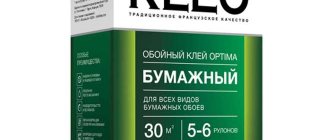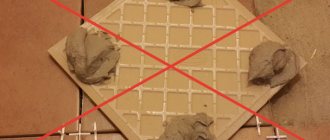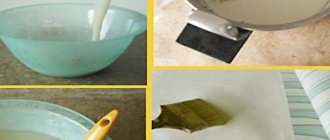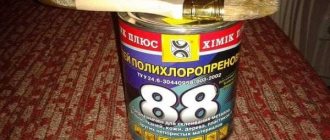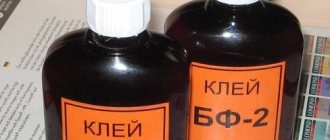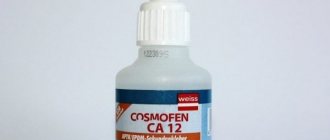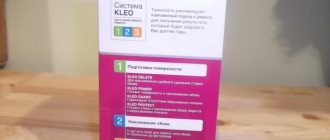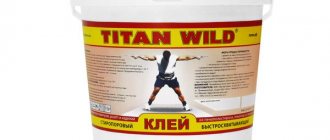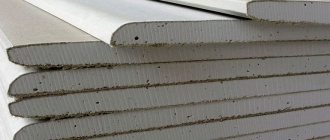Painting fiberglass web finds its application in reinforcing surfaces before finishing work. This material is not a finishing type coating, it is, so to speak, the basis for further finishing of walls and ceilings. The cobweb can be called an effective assistant in the fight against such serious problems as cracks on the surface of ceilings and walls.
Quite often, problems with cracks arise in new houses that were built relatively recently, because over time the house shrinks; painting fiberglass web, the use of which is appropriate in this case, is the best assistant in this situation.
It should also be noted that this type of finishing coating for walls today is gaining popularity in the market of finishing materials, and with quite serious momentum. The type of “preparatory wallpaper” in question has similarities and differences with glass wallpaper. We will also compare the manufacturing process of paper and fiberglass.
Technical characteristics and scope of material
Painting fiberglass canvas consists of fiberglass threads, like glass wallpaper, but the difference is that the web is not made on machines. The manufacturing process of the “wallpaper” in question is as follows: fiberglass comes under a press, as in the process of manufacturing sheets of paper. The result of such pressing is smooth, thin sheets, the surface of which is very smooth. The density of compressed fiberglass is 25-50 g/m2.
Although the process of making fiberglass webs and paper are to some extent similar, the difference between them is colossal - unlike paper sheets, they do not accumulate statistical electricity on their surface, and they are also not afraid of water, mechanical damage, or chemical reagents. Dust is also not attracted to them and, among other things, they do not burn. It is difficult for some to imagine what such a finishing material looks like, therefore, you can watch a video showing how to use fiberglass for painting in this article.
Similar characteristics of cobwebs and paper include their composition, namely, the ingredients included in its composition are exclusively natural, as in paper, they are also a non-allergenic material, and they allow air to pass through perfectly. The difference between fiberglass and glass wallpaper is the absence of a wicker pattern and relief on the surface of the former. But this also has its advantages, if there are no prominent elements on the surface, it means they can be painted an unlimited number of times, no relief - no problem.
Peculiarities
The peculiarity of glue for fiberglass is that, unlike conventional wallpaper glue, this composition is made on a latex basis. Thanks to the elasticity it creates, it allows you to adjust the canvas directly on the wall. Russian-made Oscar glue is manufactured using European technology and is especially popular among professional craftsmen.
Oscar is a universal adhesive composition suitable for different groups of wallpaper. The main features of this glue are its complete transparency after drying.
The solution is also convenient for storage, since it does not lose its characteristics for up to two weeks in a cool place.
How to properly glue painting fiberglass
In order to stick the material on the walls or ceiling, you do not need to have any special skills or knowledge. You just have to find out how it's done and get to work. If you don’t want to pay a lot of money to craftsmen for a fairly simple finishing process, then just follow the recommendations that will help you do everything correctly and quickly.
- To begin with, glue is applied to the surface of the ceiling or walls; you don’t need to apply a lot; it will be enough to apply glue one strip wide. The substance is absorbed quickly enough, so there is no need to remove it from under the finishing material.
- There are no standards for the width of the strips, you can cut them as you wish, the main thing is that it is convenient to work with them. With the finishing of the walls everything will be simpler, so you can cut the strip to its full length, but for the ceiling a strip of one and a half to two meters will be enough. Before gluing, check where the front and back sides are. They look very similar, but there is a difference in them, so you will find all the necessary information about this on the label.
- Painting fiberglass canvas: the use of which is suitable for all surfaces in the room, and even for plasterboard structures, after fitting to the wall, it is smoothed out carefully with your hands. You need to make sure that the corner of the room coincides with the edge of the web. After that, it is necessary to run a spatula over the surface so that no air remains under the coating.
- When the sheet is firmly attached to the wall, you can start cutting off all the excess that sticks out or hangs. Then apply glue to the surface again. To understand that the sheet is well soaked, it should become dark from moisture.
- We glue the next sheet, the same size as the previous one, to the wall, making sure to overlap. If the material is glued to the ceiling, then it is better to glue it along the room.
How to glue fiberglass
When gluing fiberglass to the ceiling or walls, there should be no drafts and air humidity should not exceed 75%, otherwise the glue will not adhere well.
- First, the ceiling is covered. The surface is lubricated with glue (roller). The walls are covered in the same way.
- Height differences and corners are coated separately with a brush.
- Installation of the first strip of fiberglass. It’s better to work together: one person presses the canvas to the ceiling or wall, and the second smoothes it out, running a spatula over it to prevent bubbles from appearing. On walls, it is better to start gluing from the door, laying the sheets parallel to it.
- The second strip is glued with an overlap of 3-4 cm.
- When the entire room is glued, it can be covered again with an additional layer of glue. It increases the adhesive properties of the base, making it more durable and reliable. There is no need for priming.
Pasting corners
Very often it becomes necessary to glue fiberglass in corners, and the corner can be external or internal.
If there is unevenness or excess of the canvas in the corner, the material will need to be trimmed. This is the only way to achieve a tight fit of the fiberglass to the surface.
When gluing, both sheets of fiberglass should extend beyond the corner by 4-5 cm. To form a neat joint in the corner, you need to make a cut in the center and remove the remaining material.
Trimming excess
To make a beautiful joint, without excess material, after gluing the two canvases, you need to take a ruler and a construction knife. Carefully make a vertical cut in the middle of the overlap. Thus, both canvases will be connected at one joint, and excess strips of material will simply be removed from the surface.
How to glue on drywall
When gluing to drywall, the base must first be primed. To level the walls, first all joints and places with screw heads are puttied. Then the putty areas are sanded with sandpaper and only after that the plasterboard is primed.
Drywall is primed for less absorption (to reduce mixture consumption).
Further, the principle of gluing is similar to other bases.
Glue consumption per 1m2
The question of glue consumption when finishing walls or ceilings with fiberglass paints arises quite often, because such a process will require a lot of it.
The problem is that there are no standards in this regard. It is impossible to accurately calculate the amount of glue that will be used per square meter of surface, because it will depend on who will apply this glue to the surface.
If there is little glue, you will see it yourself; if there is too much glue, it will also be difficult not to notice. In order to sufficiently saturate the surface with glue, you must monitor the color of the fiberglass web; as soon as it darkens from moisture, there is a sufficient amount of glue on its surface.
- After we have glued the second sheet with an overlap, we saturate it with a layer of glue and, without fail, press it well against the wall. In order for the seams between the sheets to be invisible, you need to cut a strip through both glued layers, even if your cut turns out to be uneven, there is nothing wrong with that, we strive to ensure that the surface is smooth, and these unevenness of the strip you cut will not be visible on wall or ceiling.
- After 24 hours, the glue on the surface will dry completely, and you can proceed to the next stage of finishing.
Painting fiberglass web application: how to paint
If you decide to paint the canvas, then we recommend using water-based paint for such a surface. Such paint will retain the properties of the finishing material itself and, moreover, more than one layer of paint can be laid on it in an even layer.
For painting you will need the following tools:
- a tray where the paint will be poured;
- a roller, preferably with a thread-type pile (you can use a paint brush, but then the painting process will take a long time).
It is necessary to paint the fiberglass spider web twice, that is, apply two layers of paint. It is worth noting that the time between applying layers should be at least 12 hours. To roll a seam, you need to use a “wing”; if you do it with a roller, the result will not be optimal. In principle, these are all the features of painting such a finishing material.
Do I need to putty on fiberglass paint before painting?
A positive quality of the web is that after gluing it to the wall, you can immediately begin painting the surface of the walls or ceiling. In this case, the word immediately means. After the surface has completely dried, simply without preliminary or preparatory work.
It is necessary to putty only if you want to have a completely flat surface of the wall or ceiling or if you want to hide the texture of the finishing material, in this case - cobwebs.
The best option for preparatory work before gluing would be to prime the fiberglass with glue, thereby reducing paint consumption. This is correct and profitable, because glue is much cheaper than paint.
Is it possible to glue wallpaper onto fiberglass webs?
To begin with, I would like to say that painting fiberglass is a material that serves to reinforce surfaces, and it is glued to secure plaster, putty, and also to avoid the appearance of cracks on the walls. This material is excellent for painting.
As for wallpaper, in the case of fiberglass, you can glue it, but before that you will have to treat the surface of the wall or ceiling, and only then start gluing the wallpaper onto the surface.
Since painting fiberglass web, the use of which is a protection against cracks, is not a finishing coating, it can be either painted or glued on top of wallpaper, but after first treating the surface.
If the gluing process seems difficult to you and somewhat incomprehensible, then we recommend that you watch the video on our website, which describes in detail and shows how to properly glue fiberglass webs to various surfaces.
Source: masterok-remonta.ru
(part A+B / 10 kg)
Source: m-delivery.ru
Application of material
The most popular application for painting fiberglass is for walls that are already plastered and finished with plasterboard. In this case, the material quite effectively replaces the finishing putty, preventing the appearance of new flaws and cracks, and hiding the old ones. At the same time, the use of fiberglass web allows you to additionally reinforce the base - a wall or ceiling - if it is impossible to use plasterboard (for example, for fear of reducing the height of an already small room due to plasterboard sheets and profiles holding them). You can also buy fiberglass instead of embossed wallpaper - installing the “web” will require less time and money.
In the absence of serious requirements for the quality of the surface, the “cobweb” does not even need to be puttied. It is enough to properly glue the material using special glue for fiberglass and paint it. Although this costs 2–3 times more paint.
Thanks to the use of fiberglass for painting, walls and ceilings are protected from cracks as a result of:
- building shrinkage;
- thermal expansion of enclosing structures;
- constant exposure to vibrations from nearby equipment, construction equipment or railways.
Fiberglass, which is glued only with special glue for webs, can also be used as an intermediate layer for polymer and vulcanized roofing materials. To ensure adhesion, the coating is protected with a cloth on one side. You can also find fiberglass in waterproofing materials, wall and floor panels, and even pipelines, for which the “web” serves as additional protection.
Advantages and disadvantages of fiberglass web
Like any material, x-glass “gossamer” has its own characteristics, positive and negative qualities.
| pros | Minuses |
| There is no need to call a professional to do the job; you can glue it yourself at home. | Work in closed clothing, a mask, and glasses to prevent glass particles from getting on your skin. |
| Resistant to chemicals. | Peeling may cause problems as the material is durable. |
| Not afraid of water. Vapor permeability. Used for kitchen, bathroom, balcony. | Not plastic. When gluing, the surface must be flat. Otherwise, the next coating will crack. |
| You can touch it with your hands and clothes every day, you won’t do any harm | High cost price. |
| Eco-friendly coating. | High paint costs. |
| Durable material. Serves in operation for up to 35 years. | The composition contains phenols, formaldehydes. |
| Decor. A wide choice of interior design: gluing non-woven wallpaper, painting walls, decorating. | Poor quality material can break and crack. |
| They are not afraid of fire. | |
| Pasted with overlap |
Technical characteristics and scope of material
If you use painting fiberglass, you will get an environmentally friendly room. Fiberglass canvas for painting is produced by many manufacturers, which one should you choose? Wellton (W30,W40,W50), Semtex, Holtex, glass, Weltex, Polinet are the best on the sales market.
The price for one roll is 500 - 800 rubles. The volume is 25 m2 or 50 m2. Universal width 1 m.
Painting fiberglass web is used in repair work of walls and ceilings. Fiberglass, Velton, properly glued to plastered or plasterboard walls. Replaces finishing putty. It is glued with special glue, primed, puttied, dried, and then painted with a roller.
If you avoid putty, you need to prime it with a liquid solution and paint it. In this case you need a lot of paint. For what? Because you need to paint 3-4 times. How to paint fiberglass spider web is presented in the video:
How to properly glue painting fiberglass with photos and videos
Is it possible to glue wallpaper onto fiberglass fiberglass? This phrase is often heard by consultants at construction stores. There is a special technology for working with the material. Before gluing, preparatory work is carried out. If the walls have minor flaws, there is no need to repair anything. If large cracks are naive, treat them with putty. After drying, apply plaster. The result is a smooth surface treated with a primer solution.
Now let's start gluing. Apply glue liberally to a dry wall or ceiling. It is recommended to apply approximately the size of one sheet. Thanks to good fit, there will be no excess glue under the fiberglass. For ease of use, cut the sheets in advance. It is important not to confuse the front side. Gradually applying the side of the canvas to the wall, you need to smooth it with your hands or a construction triangle. Remove air and excess glue after gluing in the same way. Next, remove the excess length and soak the top of the sheet with glue. After some time, smooth the finished surface with a spatula again. The other sheet is glued overlapping. Impregnate the surface with adhesive and overlap the finished glued sheet. For an even and invisible seam, you need to cut a strip through both layers. Afterwards, coat the joint well with glue. The result will be a smooth seam without any sticky tape. In the corners there is Oscar fiberglass, cut. It will take a day to dry. Next comes finishing. If the wall is to be painted, we putty the surface 2 times. For wallpaper gluing – 1 time.
Fiberglass web
Composition requirements
Fiberglass is a dense material made from the finest strands of fiberglass, which are interconnected with a synthetic polymer composition, similar to felt. It is used as a reinforcing material, a leveling layer for walls and ceilings, or as a coating for surfaces to be painted.
The glue for the web (glass host) must hold not only its weight on horizontal and vertical surfaces for a long time, but also the weight of the finishing material (wallpaper, paint, plaster, plaster). To reliably strengthen the mounting material, ordinary wallpaper glue or PVA is not suitable.
The special adhesion composition must include the following components:
- The polymer base is polyvinyl acetate (PVA). This is the main adhesive component;
- Plasticizing additives – provide optimal viscosity and elasticity of the adhesive joint, prevent the formation of cracks after drying;
- Modified starch – increases adhesion characteristics when working with glass host;
- Fungicides – prevent the formation of mold and fungal deposits;
- Polyvinyl alcohol – speeds up drying and prevents delamination.
Glue consumption per 1m2
You will need special glue for fiberglass web, such as for glass wallpaper. It’s not often that manufacturers sell it as a set of fiberglass. For quality work, you must follow the instructions correctly to avoid a liquid consistency. You need to buy glue with a reserve, because it will require a lot of consumption. Oskar-profi fiberglass painting canvas does not like through air when drying. It is recommended to close doors and windows during work. On average, 200 ml is used per 1 liter of water. glue.
We sell ready-made glue based on PVA and starch. On average, a 15 kg bucket of glue is used for 25 m2. Accordingly, 0.4 kg of glue will be used per 1 m2. You can determine exactly how much glue you need using the description on the package.
Brands of adhesives for fiberglass
- Quelyd. French brand under which the universal product BluTack is produced. A popular adhesive for fiberglass is Optima. The product is packaged in 15 liter plastic buckets. Has low consumption, moisture resistant. Optima contains bactericidal and fungicidal additives. Complete drying time is 1-2 days. After gluing, you can paint the base no earlier than a day later. Can be applied with a roller by hand or by machine.
- Oscar. Produces dry powders and ready-made mixtures. Oscar glue is known for its low consumption, high adhesion and performance capabilities. The composition is safe for humans. Does not contain toxic components, meets all sanitary standards. There is a fungicide that prevents the development of mold and mildew on the treated surface. Oscar dry powder is very economical: half a kilogram of the mixture can be diluted in a 10-liter bucket of water. No lumps are formed during stirring. The finished composition is stored for no more than two months without loss of characteristics. Consumption – 0.25 kg per 1 m2.
- Pufas. Pufas adhesives are inexpensive, but have excellent adhesive ability. These are ready-made mixtures containing antifungal additives. They are not afraid of frost and are resistant to temperature changes.
- Bostik. Product based on PVA and modified starch. Apply with a roller or brush. Bostik glue is only for dry rooms. The adhesive layer will acquire full strength no earlier than a week after application. Compatible with fiberglass, fabric-based materials, paper and vinyl.
- Kleo. French manufacturer of dry powders. Cleo Ultra glue dries quickly, is reliable, easy to prepare at home and is inexpensive. After drying it becomes transparent. During dilution, the powder does not form lumps. There are no toxic components in the composition. The prepared product cannot be stored for longer than 10 days.
- Wellton. You can glue fiberglass sheets for further painting. Contains additives that increase fire resistance. Treated surfaces are not afraid of moisture and can be washed regularly. The product is environmentally friendly, safe for humans and nature.
- Bolars Fiberfix. Ready mixture, dries quickly. Release form: 5 kg eurobuckets.
Some craftsmen glue the edges and joints of glass panels with liquid nails or sealants. If you buy high-quality adhesive mixtures, then additional gluing of the joints is not necessary, they will already be reliably protected from peeling.
Tips for choosing glue:
- Liquid glue retains its qualities for 10 days after opening.
- To prepare the dry mixture, it will take 15 minutes for swelling.
- High-quality glue does not stain, does not form stains, and is odorless.
- Colorless when dry.
- Contains antifungal components.
- The composition contains chalk for flexible application.
- Dries completely in 2 days.
The following trademarks have such characteristics: Kleo, Metylan, Quelyd, Pufas. Sold in liquid and dry form. Packaging of dry 250 and 500 grams. Liquid glue is produced in 5 kg, 10 kg, 15 kg.
Tip: It is not recommended to save and add more water, otherwise the material will not be strong and will begin to peel off.
Source: otdelkasam.ru
Glass wallpaper adhesive Quelyd
Quelyd is another brand that sells both ready-made glue and dry mixture for glass wallpaper. The dry mixture is packaged in 500 g, ready-made glue is sold in 5 and 10 kg (in plastic buckets).
The properties and features of “Quelyd Glass Wallpaper” or Quelyd Murale, which are indicated by the manufacturer, reassure buyers.
- In order for the finished mixture to be applied to the wall evenly and easily, chalk is added to the composition.
- It also contains fungicides that prevent the development of fungi and mold.
- Suitable for both manual and machine application.
- Swelling occurs within 15 minutes.
- Working properties are maintained for about 10 days.
- Colorless after drying.
- Does not react with paints.
- It takes about 48 hours for final drying.
- To coat joints, it is recommended to purchase special tubes of Quelyd Raccord to ensure reliable fixation when gluing fabrics “joint to joint.”
The opinion of those who have used this adhesive mixture fully corresponds to the stated characteristics.
Advantages of glue
“Oscar” is a water-dispersible acrylic adhesive composition, which was developed in Russia according to European standards specifically for decorating surfaces with glass wallpaper and covering walls with fiberglass for further painting.
The main advantage of glue is ease of use. The liquid composition is applied not to the canvas, but to the surface to be decorated. “Oscar” is elastic, so even the glued canvas can be easily adjusted. Other advantages of glue:
- Invisible after drying. The dried wallpaper adhesive becomes transparent.
- Quick cooking. Oscar is diluted with cold water, swells in 10 minutes and does not form lumps.
- Versatility. The diluted mixture is used to glue fiberglass canvas, fiberglass, non-woven and paper wallpaper. Oscar is applied to concrete, brickwork, and other substrates.
- The antiseptic in the composition prevents the appearance of fungus and mold, even if the room is very humid.
- Economical. To prepare 3 liters of the mixture you will need only 100 g of dry powder. The consumption of finished glue does not exceed 350 g per 1 square meter. m of canvas.
- Eco-friendly and safe, does not pose a threat to the health of people and pets.
On a note! Oscar glue can be stored well in its finished form in a tightly closed container for 2 months.
Advantages
Oscar adhesive is designed for gluing “gossamer” to non-absorbent surfaces such as concrete, plastic, primed drywall. The adhesive solution is applied to the surface of the base, and not to the canvas itself, which ensures ease of pasting.
Like many other professional materials, Oscar must be left for 5-10 minutes after mixing, mixed again, and only then started to use. After a long period of inactivity, the adhesive should be thoroughly stirred before reuse.
Oscar glue has the following advantages:
- ecologically pure;
- universal, as it is suitable for fiberglass, heavy types of wallpaper and other materials;
- used for wet areas;
- hardens within 10–15 minutes, which allows you to move the wallpaper on the wall, drawing joints;
- transparent after drying;
- frost-resistant.
Characteristics
Dry mixture "Oscar" is sold in:
- 200 gram and 400 gram cardboard packages;
- kg and 10 kg bags.
The finished glue is packaged in plastic containers of 5 or 10 kilograms.
Ready composition
Oscar liquid adhesive mixture for interior work can be stored for up to 3 years in unopened packaging. The composition is frost-resistant; you can keep the container with glue for a month at temperatures down to -40 degrees. However, it becomes unusable after the 5th defrost.
Dry adhesive mixture
The one-component adhesive composition "Oscar" for interior work is also frost-resistant, but the shelf life is less than that of the liquid mixture and is 2 months. The product is odorless.
Types of mixtures
In construction stores you can find ready-made solutions for steklohost or dry mixtures for dilution. In addition, there is also fiberglass fabric already impregnated with glue, you just need to wet it.
Ready-made mixtures for fiberglass
To speed up finishing work with fiberglass, ready-made solutions are used. They can be applied directly from the packaging to the installation material. Usually sold in containers from 0.5 to 5 liters. When using them, the reliability of adhesion depends on the quality of the mixture.
Check the expiration date and integrity of the packaging.
Once opened, finished formulations are stored for no more than 10 days. When purchasing, choose the smallest size. The approximate material consumption is indicated by the manufacturer on the packaging.
Dry powder for fiberglass
Its advantage is that it can be diluted and used in portions. You can independently choose the volume of powder for preparing the solution. Dry mixtures are diluted with water; manufacturers indicate the proportions on the packaging. Strictly follow the recommendations for preparing the composition.
Consumption
Glue is economical. The consumption of the finished composition differs depending on what it is used for. 10 kg of dry mixture is enough to stick:
- 50 sq. m of glass wallpaper;
- 66 sq. m of non-woven fabrics.
The same number of kilograms will go into a primer of 132 square meters. m of prepared surface.
Important! If a person uses a ready-to-use Oscar adhesive mixture, then 5 kg of wallpaper glue is enough to glue 20-25 square meters. m of canvas.
What is a "web"
Painting fiberglass is an environmentally friendly and lightweight material created on the basis of fiberglass and organic resin. It is a non-woven fabric, very tear-resistant and does not have a clear pattern. The surface of the canvas consists of fibers, which, unlike glass wallpaper, do not intertwine and are arranged in a chaotic manner. And the material got its name due to its soft and pleasant to the touch texture.
Depending on the thickness, the “web” is divided into classes. On the market you can find options with densities from 25 to 65 g/m2. m. The higher this indicator, the stronger the surface finished with fiberglass will be. However, for ceilings, on the contrary, it is recommended to choose a lighter option that adheres better to a horizontal surface.
Instructions for use
A person interested in quality studies the rules for preparing the mixture and using the adhesive composition. Before starting work, prepares tools:
- A container in which the required amount of glue is diluted.
- Roller or wide brush for applying the composition.
- Wooden spatula.
- A clean rag to wipe off excess glue.
- Spatulas: wide metal - for leveling the surface before gluing, and plastic - for smoothing glued glass wallpaper.
- A utility knife to cut off any remaining wallpaper.
- A convenient stepladder.
Important! When working with Oscar glue, wear protective gloves.
Preparing the walls
Before applying the finished adhesive composition, the surface:
- thoroughly clean with water to remove dirt and dust;
- remove the remains of old wallpaper, peeling plaster, whitewash;
- cracks, seams, and irregularities are cleaned with sandpaper;
- the shiny smooth surface is brought to a matte state;
- The walls are leveled using gypsum plaster, then they are puttied and sanded.
Finally, the walls or ceiling are primed with diluted Oscar wallpaper glue or latex primer. The procedure fixes weak, chalking or crumbling substrates. After applying the primer coat, the wall or ceiling is allowed to dry for about 2 hours.
Preparation of the composition
Prepare the working mixture as follows:
- Pour the required amount of cold, clean water into a clean plastic container.
- Stirring continuously, pour the dry mixture into the center of the funnel formed during stirring in a thin stream.
- Leave the adhesive mixture to swell.
- Stir again after 5-10 minutes until a homogeneous thick mass is formed.
Start gluing the surface with glass wallpaper or fiberglass.
On a note! If a ready-made adhesive mixture is used for work, the composition also needs to be mixed before gluing the surfaces.
Applying glue
“Oscar” is applied with a roller or a wide brush, evenly distributing it over the surface to be decorated, wall, ceiling. Make sure that the adhesive layer is:
- sufficiently thick (at least 0.5 mm);
- wider than the glued canvas.
Fiberglass fabric is glued to the surface immediately after application and distribution of the composition. After this, within 20 minutes you can adjust the position of the canvas on the wall or ceiling. Align the canvases using a spatula, from the middle of the strip to the edges, using a herringbone motion. Glass wallpaper has a porous structure, so the glue “seeps” through the canvas. The leaked excess is evenly distributed over the canvas with a clean rag. Fiberglass is glued end to end.
Mandatory conditions when gluing glass wallpaper:
- The room should not be too humid.
- Work is carried out at temperatures from +10 to +23 degrees.
- No drafts allowed.
- Protect the surface from direct sunlight until the Oscar glue dries.
On a note! If the glass sheet is glued for further painting, then wait at least 3 days for the glue to dry before starting painting work.
Technology of use
A relatively flat surface must be primed. The manufacturer Oscar has its own line of priming mixtures that can be used. After the wall has completely dried, use a roller or a large wide brush to apply a composition 1–1.5 millimeters thick to the base (ceiling, wall, etc.). The area treated with glue should be slightly larger than the width of the canvas, which allows for subsequent adjustments directly on the surface. Next, like other wallpapers, the fiberglass canvas is leveled with a spatula to remove excess glue under the canvas.
Experts recommend following these recommendations when using Oscar glue:
- for a stronger bond, the room temperature should be at least +10 degrees, but not more than +23 degrees;
- humidity should be less than 70%;
- during pasting of surfaces, as well as drying of the mixture, there should be no draft in the room;
- Do not expose packaging and finishing to direct sunlight during drying;
- Shelf life when unopened is up to 2 months.
- The glue dries completely after 2 hours. For subsequent staining, it is necessary to wait a day.
Analogues of Oscar glue
The following analogues are presented on the building materials market:
- Quelyd Optima is made in Sweden and is universal. The composition is suitable for gluing glass wallpaper and non-woven fabrics. It is applied to the surface with a roller, by machine. Moisture resistant. Consists of modified starch, vinyl additives. For 1 sq. m requires up to 250 g of glue. Sets within 24-48 hours.
- "Optimist" is an inexpensive domestic adhesive suitable for glass wallpaper. Becomes transparent after drying. Sold in plastic packaging of 5 or 10 kg. For 1 sq. m requires up to 0.5 liters of adhesive composition.
- Homakoll 202 is a universal water-dispersion adhesive for glass wallpaper, structured fabric and fiberglass. Sold ready to use in 10 kg containers. For 1 sq. m requires up to 300 g of glue.
Oscar glue can be purchased in both liquid and dry form, in packages of different sizes. It is convenient and safe to work with the composition, and the quality of the material guarantees a decent result.
Source: kraska.guru
Glue consumption for fiberglass per 1m2
How to choose wallpaper glue
When choosing wallpaper glue, you must proceed from the information about the wallpaper itself, which is written on the label for it. The consumption of wallpaper glue per 1m2 is always written on the packaging (see photo). You can refer to our table.
In the production of wallpaper glue, there are several types of adhesives, these are:
- adhesive composition for paper-based wallpaper: light single-layer, duplex (embossed and smooth), corrugated, ceiling, washable; heavy wallpaper (coarse fiber), structural, foam wallpaper.
- Adhesive for non-woven and vinyl wallpaper. As part of the adhesive for vinyl and non-woven wallpaper, methylcellulose is added to the main components (starch and antifungal additives) (find out how long it takes non-woven wallpaper to dry);
- Universal adhesive designed for different types of wallpaper. The universal glue is based on modified starch and components that prevent the appearance of fungus.
- In addition to special-purpose adhesives, a universal adhesive is also produced. This glue can be used for wallpaper of any type. It contains esters of modified starch and antifungal substances.
